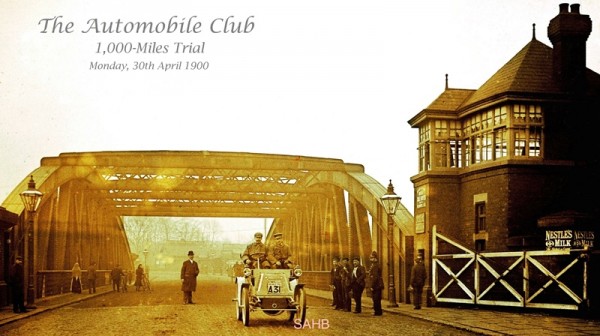
Of the 65 cars and their occupants that had set off from London for the 1,000-Miles Trial on Monday the 23rd of April 1900, almost all had by day five of the event arrived in Manchester. The pavilion at the Botanical Gardens served as the garage for the cars over the weekend and for the princely sums of two then one shilling entrance fees the public were able to view the assembled vehicles. However, once the cars were out on the road, they could be seen in action, and for free.
Although the London to Brighton Run of November 1896 had been the first significant motoring road event in Britain, and there had been other similar outings in subsequent years, the purpose of the 1,000-Miles Trial was to introduce the motor car to as wide a range of the public in as much of the country as possible. Therefore the industrial areas of the Midlands and North of England were not by-passed and the participants also travelled as far as Glasgow and Edinburgh before the return to London.
This shot shows car number A-31 leaving the Manchester halt and having just crossed the Ship Canal by means of the 70-yard long hydraulically operated Trafford Road Swing Bridge which had been built eight years earlier. The 30 miles northwards on to Preston were strictly controlled with an 8 mph speed limit imposed, and no overtaking of other participants being permitted. This was in part because of the uneven state of the mainly cobbled roads, much horse-drawn traffic, and the population density of the area. It also accounted for the start time of 7 o’clock in the morning.
A-31 was the 6hp Daimler driven by ‘William Exe’, this being the pseudonym used in these circumstances by the principle organiser of the event: Claude Johnson, who at the time was Secretary of the Automobile Club. He had surveyed the whole route during late December 1899 on a smaller Daimler in company with Montague Grahame-White and they probably had more of an adventure with unknown roads to explore and much heavy snow to contend with than they did on the actual Trial. The event was completed successfully by most of the participants, and it also achieved its broader aims.






